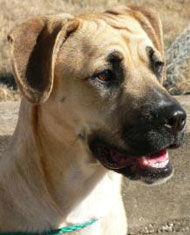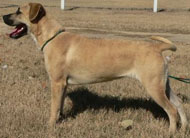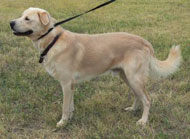BSL requires all dogs to be categorized by breed. But breed identification is not as easy—or as objective—as you think.
Do you know what a “pit bull” looks like? Take a quick break and see if you can find the American Pit Bull Terrier. Better yet, see if you can identify ALL of the dogs’ breeds before you click for the answer.
Can you spot a “pit bull” mix? Look at these photos and then check the bottom of the page for matching DNA results.
Can you spot a “Lab mix”? Look at these photos and then check the bottom of the page for matching DNA results.
Okay, so maybe you’re not a breed identification expert. But, surely people who handle a lot of dogs are better at identifying dogs’ breeds? Not according to the following studies about animal shelter breed labeling:
Comparison of Adoption Agency Breed Identification and DNA Breed Identification of Dogs (2010)
Incorrect breed identification costs dogs their lives (2012)
Breed identification and purebred/mixed breed dogs
Breed-specific legislation, by definition, restricts dogs based on their breed. This requires breed identification of each and every dog.
Breed identification might be easy when a dog is purebred, has a pedigree, and is registered with a kennel club. However, this makes up only a very small fraction of all dogs in the U.S. In 2006, an estimated 72 million dogs lived in households in the U.S. (U.S. Pet Ownership & Demographics Sourcebook (2007 Edition)) How many of these dogs are purebred, pedigreed, and registered? Though I have seen one estimate put the number at 25 percent, I believe that to be extremely high. The actual number of purebred, pedigreed, registered dogs is difficult, if not impossible, to estimate.
Even using this highest estimate, that leaves 75 percent or more of the U.S. canine population without any sort of traceable lineage. Some of these dogs are undoubtably purebred, though they may lack any sort of historical paper trail to prove it. Their appearance is close enough to a breed standard that owners can confidently say that their dog is of a specific breed.
The vast majority of canines, however, are mixed breed dogs. And though we tend to think of mixed breed dogs as the offspring of two purebred dogs (Mastiff x Boxer = Mastiff-Boxer mix), the reality is far more complex. Most mixed breed dogs are a genetic mishmash resulting from several generations of mixed breed dogs interbreeding. The end result is incredibly complex.
To make things more confusing, a dog that doesn’t really meet any single breed standard may be categorized as a type of dog rather than a specific breed. Dogs may be identified as terriers, pit bulls, shepherds, or retrievers; none of these are actual breed names, and the breeds that really do make up these categories come in a startling variety of shapes, sizes, and colors. There’s a huge difference between an Airedale Terrier and a Jack Russell Terrier, so what does a “terrier mix” describe?
Breed identification for BSL is based on a dog’s appearance alone.
The primary means of breed identification for non-pedigreed dogs and mixed-breed dogs is a visual glance and a guess. The dog may be compared with the breed standard for a breed; again, this is based on visual assessment. It is entirely subjective.
Ontario Attorney General Michael Bryant, who pushed for a ban on pit bulls in Ontario, proposed this manner of identification:
“I’ve said before and I will say again, if it walks like a pit bull, if it barks and bites like a pit bull, wags its tail like a pit bull, it’s a pit bull.” (Ontario Hansard 38-1, November 4, 2004)
Dog warden Tom Skeldon, the driving force behind Ohio’s BSL, testified before the court in Tellings v. Toledo (2006) that
“even if a dog was 50 per cent pit bull, if it did not ‘look like a pit bull,’ the owner would not be charged. On the other hand, if a dog did ‘look like a pit bull,’ it would be classified as a pit bull and the owner would be subject to the ‘vicious dog’ laws.”
Who identifies breeds for BSL?
To know whether BSL affects any particular dog, breed determination is usually made by an animal control officer or a veterinarian (depending on how the law is written). However, contrary to popular assumption, veterinarians and animal control officers—despite handling many dogs for a living—are not trained in breed identification. For the most part, they are no better than average citizens at breed identification.
Animal Control Officers (ACOs) and Workers There are not many hiring requirements to get a job as an animal control officer or shelter worker (the major requirement is having a physical ability to do the work, which may include picking up or restraining large animals). Being able to accurately and certainly identify dog breeds is decidedly not a requirement. Because AC departments are usually understaffed and underfunded, any sort of official training is minimal (most officers learn their duties on the job), and breed identification training is a complete rarity. Additionally, ACOs do not generally learn breed identification on the job to any great degree, because they rarely, if ever, receive feedback regarding their breed designations—so they have no idea if they are labeling dogs correctly or incorrectly.
Veterinarians Veterinarians do not have to be trained in breed identification to receive a veterinary license—and most aren’t. In fact, most veterinarians don’t even receive training in dog behavior. Their focus is on treating disease, and they don’t need to know a dog’s breed to diagnose and treat disease.
Checklists for Breed Identification
Some places with BSL use checklists for breed identification in an attempt to standardize and objectify identification processes. Some checklists are very short, while others tick off dozens of characteristics in great detail. The person performing the identification may be asked to choose along a sliding scale whether a particular dog matches or does not match a particular characteristic on the checklist.
Unfortunately, these checklists consist almost entirely of subjective characteristics. Using descriptive—but unmeasurable and nonscientific—words like “medium length,” “broad,” “high,” and “strong,” the checklists ask their users to draw personal conclusions about whether a particular dog matches each item. Below is a pit bull checklist put out by the city of San Francisco.
| San Francisco, CA Pit Bull Checklist The City and County of San Francisco, Department of Animal Care and Control considers a dog to be predominantly a pit bull breed (American Staffordshire Terrier, American Pit Bull Terrier, or Staffordshire Bull Terrier) if s/he possesses 5 out of the following 8 characteristics:
|
Let’s apply this checklist to some dogs.
|
Dusty
Dusty gets a 6 out of 8, which makes him a pit bull, according to the checklist. Do you agree with my evaluation? |
|
Luke
Luke gets a 7 out of 8, which makes him a pit bull, according to the checklist. Do you agree with my evaluation? |
DNA-Based Breed Identification Tests
The DNA-based breed identification tests currently on the market are not yet accurate enough for widespread use; they only recognize around 100 of the 400 to 800 dog breeds out there. Further, these tests are neither cheap nor quick.
When it comes to most mixed breed dogs (most pet dogs) the results that come back usually confirm that these mixed breed dogs are heavily mixed and contain only small traces of certain breed markers. Unfortunately, these results may serve to “taint” a dog when it comes to BSL; a dog with only a minute amount of “American Staffordshire Terrier” detected in its genes—perhaps only one of its great-great-great-great grandparents was a purebred AmStaff—is nevertheless considered a “pit bull mix” and is therefore subject to BSL.
It smacks of the “one-drop rule” of Jim Crow laws.
An interesting related article: Mutts Decoded in the Boston Globe, August 2, 2008
According to the article:
“The results of the [DNA] testing have been so startling that the Animal Rescue League is planning to stop making educated guesses about mixes and will instead label all mutts as American shelter dogs. The shelter the Massachusetts Society for the Prevention of Cruelty to Animals runs at Angell Memorial Hospital is considering a similar change, although the MSPCA prefers the term New England mutt.”
 Here are some breed-id DNA test results for my dog, Dozer. Judge for yourself how accurate they are.
Here are some breed-id DNA test results for my dog, Dozer. Judge for yourself how accurate they are.
Test #1 “Distant traces of” American Staffordshire Terrier, Bull Terrier, Bulldog (trace amount at low confidence), Dalmatian (trace amount at low confidence). “There are also faint signals from other breeds which are not strong enough to identify.”
Test #2 Bulldog (between 20-36%), Parson Russell Terrier (between 20-36%), Rottweiler (between 20-36%), Poodle (between 10-19%), Boston Terrier (less than 10%)
We call Dozer a “pit bull mix” because that’s what the pound called him when we adopted him as a tiny puppy—but in fact he’s not one, not two, not even three, but a crazy jumble of breed types… making him a good ol’ American mutt, really.
Yet, society is never satisfied with the label “mutt.” BSL does not allow dogs to be called mutts. They must be given a primary breed designation, even if such a designation does not match reality.
Misidentification in the Media
When it comes to dog attacks, the media has never had a good track record of accuracy, particularly when it comes to identification of the breed of dog involved. Many journalists, whether in their haste to meet deadlines or because they simply don’t care, do not make the effort to correctly and carefully identify the breed of the dog involved in the attack.
Of course, one has to ask—how does anyone really know what breed the dog is in the first place?
Did the journalist ask the victim? We have seen here how difficult it is to identify a dog by breed. Victims are certainly not dog breed experts. And in some cases, it is that very ignorance about dogs that makes the person a victim in the first place.
Did the journalist ask the dog owner? Dog owners often have no better idea what their dog’s breed is. Unless they purchased a purebred dog, complete with authentic pedigree and kennel club registration, a dog owner’s statement of his/her dog’s breed is probably going to be based on the identification made by the person or place where they got the dog. This may be a backyard breeder, a flea market, a neighbor, a friend, or an animal shelter. Do any of these providers really know what breed the dog is?
Did the journalist ask animal control? As mentioned above, animal control officers and animal shelter workers are not breed identification experts, nor are they required to be. ACOs are going to give their best guess, or they will go with whatever the dog owner says the dog’s breed is.
Does it really matter what breed the dog is? Actually, no. Dog attacks follow a fairly predictable pattern involving a handful of factors such as reproductive status of the dog, function of the dog, containment method used, and so on. Reporting the dog’s breed (or supposed breed) serves no real purpose except for description (and the connotations and stereotypes that follow). It does not educate readers how to avoid a similar event.
But misidentification has serious ramifications. Dog attacks that make headlines can stir up public animosity toward a particular breed or type of dog. This animosity can lead—where else?—to calls for BSL against certain types of dogs.
Breed Identification Is Tough—And It Doesn’t Make Us Safer
If you own a dog, you probably already know that most people can’t identify dog breeds; it is a universal dog owner experience to be asked “What kind of dog is that?” by a friendly passerby.
The popularity of breed-identification DNA tests, despite their questionable accuracy, further indicates that even dog owners don’t really know what their dogs’ breed makeup is.
Even assuming we could definitively identify every single dog’s breed or mix precisely, where do we go from there?
A dangerous dog isn’t dangerous because of the shape of its eyes or the breadth of its chest; a dangerous dog is dangerous because of the way it behaves.
DNA-based breed id tests suggest physical features and possible temperament traits, but they definitely don’t tell you what an individual dog’s behavior is going to be like. As any animal or human behaviorist, psychologist, biologist, or anthropologist will tell you, a living creature’s behavior is the result of a combination of genetics and environment.
So even if we do establish, definitively, that a dog has a “pit bull” for a distant ancestor, how does that make us safer? Does it really make sense to spend our energy worrying about a single drop of blood?
Sources and Resources
A Comparison of Visual and DNA Identification of Breeds of Dogs (AVMA July 2009), Victoria Voith, Ph.D., DVM, DACVB
Comparison of Adoption Agency Breed Identification and DNA Breed Identification of Dogs (presented at ACVB/AVSAB July 2010), Victoria Voith, Ph.D., DVM, DACVB
Can you identify a “pit bull mix”?
Incorrect breed identification costs dogs their lives, Maddie’s Fund, Feb 2012.
Next Page: Attraction to Danger
Previous Page: Expense









Pingback: Sarnia, Ontario, Canada: Dogs to be released by city « Stop BSL
Pingback: Breed Identification: New articles and an interactive quiz « Stop BSL
Pingback: UK: Campaign launched after pet seized under Dangerous Dogs Act « Stop BSL
Pingback: Denver, CO: Johnson: If experts cannot ID dog breeds, how can cities? « Stop BSL
Pingback: Denver & Aurora, CO: Disabled vets file discrimination suit due to “pit bull” bans « Stop BSL
Pingback: Topeka, KS to consider removal of BSL « Stop BSL
Pingback: Victoria Mandates Culling of Family Pets | Good For Dogs
Pingback: Pit Bulls aren’t the Problem | problemwithwashington
Pingback: Bully Breed Advocacy: What TO Say | Perpetual Confusion
Pingback: The American Shelter Dog by Kellie Roberts, Director of Canine Programs & Services | animalcaresanctuary
Pingback: Pitbulls... - Page 13 - US Message Board - Political Discussion Forum
Pingback: NorCalBiostat | Do what you love, love what you do: Proud to be a statistician!
Pingback: What is BSL? | Zombies & Dogs